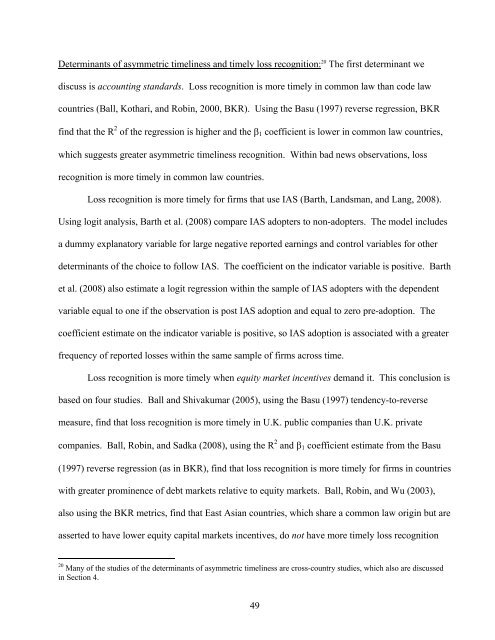Understanding earnings quality - MIT Sloan School of Management
Understanding earnings quality - MIT Sloan School of Management
Understanding earnings quality - MIT Sloan School of Management
You also want an ePaper? Increase the reach of your titles
YUMPU automatically turns print PDFs into web optimized ePapers that Google loves.
Determinants <strong>of</strong> asymmetric timeliness and timely loss recognition: 20 The first determinant we<br />
discuss is accounting standards. Loss recognition is more timely in common law than code law<br />
countries (Ball, Kothari, and Robin, 2000, BKR). Using the Basu (1997) reverse regression, BKR<br />
find that the R 2 <strong>of</strong> the regression is higher and the β1 coefficient is lower in common law countries,<br />
which suggests greater asymmetric timeliness recognition. Within bad news observations, loss<br />
recognition is more timely in common law countries.<br />
Loss recognition is more timely for firms that use IAS (Barth, Landsman, and Lang, 2008).<br />
Using logit analysis, Barth et al. (2008) compare IAS adopters to non-adopters. The model includes<br />
a dummy explanatory variable for large negative reported <strong>earnings</strong> and control variables for other<br />
determinants <strong>of</strong> the choice to follow IAS. The coefficient on the indicator variable is positive. Barth<br />
et al. (2008) also estimate a logit regression within the sample <strong>of</strong> IAS adopters with the dependent<br />
variable equal to one if the observation is post IAS adoption and equal to zero pre-adoption. The<br />
coefficient estimate on the indicator variable is positive, so IAS adoption is associated with a greater<br />
frequency <strong>of</strong> reported losses within the same sample <strong>of</strong> firms across time.<br />
Loss recognition is more timely when equity market incentives demand it. This conclusion is<br />
based on four studies. Ball and Shivakumar (2005), using the Basu (1997) tendency-to-reverse<br />
measure, find that loss recognition is more timely in U.K. public companies than U.K. private<br />
companies. Ball, Robin, and Sadka (2008), using the R 2 and β1 coefficient estimate from the Basu<br />
(1997) reverse regression (as in BKR), find that loss recognition is more timely for firms in countries<br />
with greater prominence <strong>of</strong> debt markets relative to equity markets. Ball, Robin, and Wu (2003),<br />
also using the BKR metrics, find that East Asian countries, which share a common law origin but are<br />
asserted to have lower equity capital markets incentives, do not have more timely loss recognition<br />
20<br />
Many <strong>of</strong> the studies <strong>of</strong> the determinants <strong>of</strong> asymmetric timeliness are cross-country studies, which also are discussed<br />
in Section 4.<br />
49
















